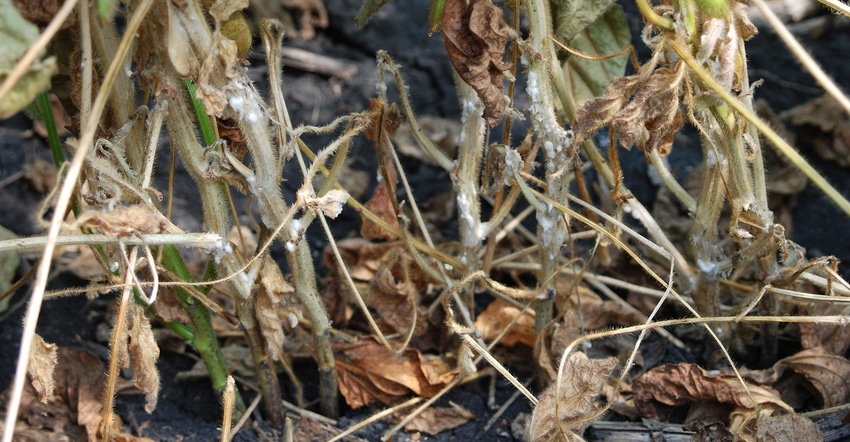June 14, 2018

By Dan Marzu
When the words “white mold” are spoken, many people have images of a fuzzy white fungus that causes premature death of soybeans or a dark material that causes discounts at the grain elevator. While white mold, or sclerotinia stem rot, can be devastating to crop yields and the bottom line, it can be managed to decrease its impact.
To understand how to control white mold, you need to understand its life cycle. The fuzzy white “stuff” found on soybean plants is the vegetative part of the fungus called mycelium. The mycelium forms the hard, black material called sclerotia that are found inside the stems and pods.
According to the American Phytopathological Society, the sclerotia allow the fungus to live in the soil without a plant host for up to five years. The sclerotia develop into tan mushrooms that are a quarter to a half inch in diameter. When scouting for these mushrooms, do not confuse this fungus with the bird’s nest fungus. The bird’s nest fungus looks like a small nest containing structures that look like eggs. It only grows on decaying material and is not harmful to plants.
White mold spores
The white mold mushroom produces spores and ejects them into the air, where they are carried into the crop canopy to infect weak spots on the plant. If this occurs during the beginning of pod formation (R3 to R6 growth stages), the spore enters the plant where the flower was and begins forming the mycelium, which produces the sclerotia — starting the cycle once again to infect future crops.
For white mold to establish, it needs temperatures below 85 degrees F, normal to above-normal rainfall, prolonged leaf wetness caused by morning fog, and high humidity. Certain natural areas, such as tree lines around a field that reduce airflow, also create an environment suitable for white mold. Though you cannot control the weather, and removing some of these natural areas may be difficult, there are other methods for preventing white mold.
For fields with a known history of white mold, work with your seed professional to determine which varieties perform better under high white mold pressure. The current University of Wisconsin-Extension Wisconsin Soybean Variety Performance Trials also provide information regarding yield performance in areas with high white mold pressure.
Other preventative measures in fields with a known history of white mold include controlling other host weeds and modifying the rotation to not include other host crops. The American Phytopathological Society identifies several weeds common to Wisconsin as hosts: Canada thistle, Jerusalem artichoke, lambsquarters, mustard, nightshade, pigweed, ragweed, shepherd’s purse, sow thistle, velvetleaf and vetch. Other crops that are susceptible to white mold include beans, sunflowers, canola, carrots and cole crops such as cabbage, broccoli and cauliflower.
It is recommended to rotate out of susceptible crops for two or three years to a nonhost crop such as corn, small grains or forage grasses.
Air movement key
Air movement through the canopy is key to reducing white mold. To increase air movement, choose varieties that are not prone to lodging and have a more erect plant structure. Also, using wider row spacing and lower plant populations may lower the risk of white mold establishing in the crop.
Using tillage to prevent white mold may only provide short-term results. While tillage may bury the sclerotia, there is the possibility that the next time the field is tilled, the sclerotia may be brought back to the surface. No-till systems have shown more sclerotia near the soil surface; however, research has shown that if left undisturbed, the number of sclerotia tends to decline.
Regardless of tillage practices, it is important to clean tillage, planting and harvesting equipment to prevent the spread of white mold fungus.
To assist farmers with decisions on when to apply fungicides to control white mold in soybeans, the UW-Madison Nutrient and Pest Management Program has developed a free app called Sporecaster. This app is available in both Android and Apple platforms.
For more information on managing white mold in soybeans, check out Extension field crops pathologist Damon Smith’s Wisconsin Field Crop Pathology website, or contact your local county UW-Extension agriculture educator or agent.
Marzu is the Extension ag educator for Lincoln and Langlade counties.
You May Also Like




